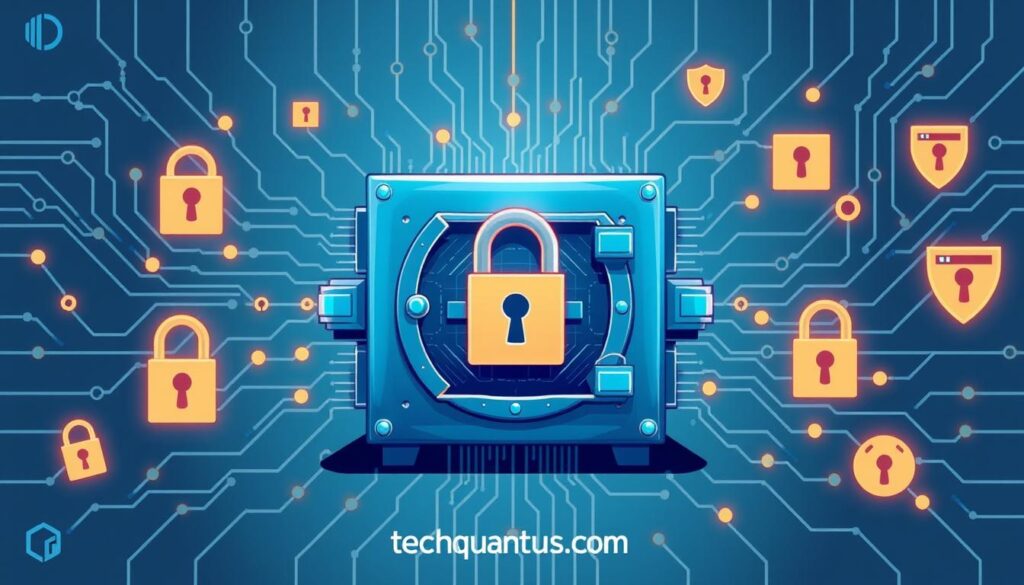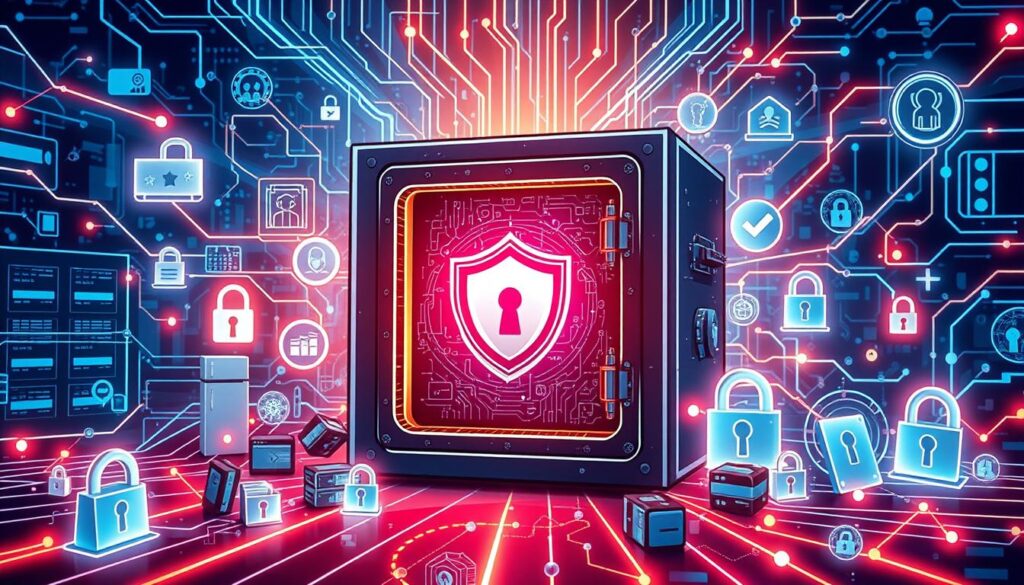Did you know that over 60% of small businesses fail within six months after a data breach? This shows how vital asset security is in today’s digital world. Asset security is a key part of the CISSP Domain 2. It helps protect an organization’s sensitive data and valuable assets.
By learning and using good asset security practices, you can keep important information safe. This is key for any cybersecurity expert. It makes sure information stays *confidential, available, and integral* to your organization’s work.
The CISSP Domain 2 is the foundation for understanding information security governance. This section will teach you the basic principles of asset security. It shows how important it is for protecting data and keeping organizations’ reputations and stability safe.
Key Takeaways
- Asset security is crucial in protecting an organization’s sensitive data.
- Over 60% of small businesses are affected by data breaches.
- CISSP Domain 2 focuses on information security governance.
- Confidentiality, availability, and integrity are key concepts in asset security.
- Understanding asset security is essential for cybersecurity professionals.
- Effective asset security safeguards not only data but also organizational reputation.
Understanding Asset Security
Asset security is key in information security. It protects an organization’s most valuable things. This includes keeping assets safe from unauthorized access, loss, or damage. Knowing what asset security is helps everyone in an organization manage risks better.
Definition and Scope of Asset Security
Asset security covers protecting digital and physical assets. Digital assets are things like databases and software. Physical assets include hardware and the places they are in. Understanding these helps you protect your organization’s assets well.
To learn more about asset security, look at these points:
- Identification: Knowing what assets you have is the first step in protecting them.
- Classification: Sorting assets by value and risk helps in planning their protection.
- Protection: Using security controls and measures helps keep assets safe from threats.
Understanding asset security is vital for a strong information security plan. It helps in creating good risk management strategies. These strategies protect your organization’s important resources.
| Asset Type | Description | Protection Measures |
|---|---|---|
| Digital Assets | Includes software, databases, and sensitive information. | Encryption, access control, regular audits |
| Physical Assets | Comprises hardware and environmental resources. | Physical locks, surveillance systems, security personnel |
| Intangible Assets | Encompasses intellectual property and company reputation. | Legal agreements, brand protection measures |
Importance of CISSP Domain 2
Asset security is key in today’s digital world. CISSP Domain 2 is vital for protecting both physical and digital assets. It helps professionals keep sensitive info safe and follow rules.
People with this domain do great for their companies. They can make their employers over $30,000 more each year. A survey shows they work better, solve problems faster, and keep employees happy.
As cyber threats grow, so does the need for CISSP Domain 2. It’s not just a badge; it’s a crucial tool for cybersecurity experts. Staying up-to-date with asset security is vital to fight off threats and keep organizations strong.
Getting certified in CISSP Domain 2 can boost your career and your salary. It’s a smart move for your career and helps your company stay safe online.
| Certification | Average Salary (USD) | Key Benefit |
|---|---|---|
| AWS Certified Security – Specialty | $203,597 | High demand in cybersecurity |
| CISSP | Varies significantly | Comprehensive understanding of asset security |
| Other Relevant Certifications | Approximately $30,000 increase | Enhanced organizational capability |
CISSP Domain 2: Key Concepts in Asset Security
Getting good at asset security for CISSP means knowing key ideas. Asset management is a big part of it. It’s about finding, sorting, and keeping track of assets from start to end. This way, companies can protect important data from harm.
Data classification is also very important. It sorts data by how sensitive and important it is. This lets companies use the right security for each type of data. Knowing what data is most valuable helps lower risks.
Managing risks and the whole life of an asset is another key part. The Asset Management Lifecycle keeps security up to date. It makes sure data stays safe and follows rules.
To follow the best information security practices, you need to stick to certain rules. The CISSP framework helps manage risks and keep data safe. Keeping up with new ideas in the field is also key to doing well.
| Key Concept | Description | Related CISSP Domain |
|---|---|---|
| Asset Management | Managing assets throughout their lifecycle including classification and maintenance. | Domain 2 |
| Data Classification | Grouping data based on sensitivity to apply appropriate security measures. | Domain 2 |
| Lifecycle Management | Monitoring assets from acquisition to disposal for risk mitigation. | Domain 2 |
Knowing these key ideas helps you do a better job of keeping assets safe. It also helps meet the goals of CISSP. This makes for a safer place to work.
Information Security Governance and Asset Management
Knowing about information security governance is key to protecting your organization’s data. It lays the groundwork for how assets are managed from start to end. Good governance helps keep assets safe by identifying, classifying, and controlling them.
Asset management is crucial for following these governance rules. It helps your organization stay in line with laws and standards. A strong asset management plan lets you keep an eye on your assets’ security all the time. This is vital for keeping sensitive info safe and making your organization strong.
Having clear policies for managing assets shows how important information security governance is. These policies should cover who is responsible, how data is handled, and how to deal with threats. A solid governance structure helps with following rules and builds a security-aware culture in your organization.
| Aspect | Information Security Governance | Asset Management |
|---|---|---|
| Purpose | Framework for managing information assets. | Strategy for overseeing asset lifecycle. |
| Focus | Policies and compliance with regulations. | Identification and classification of assets. |
| Importance | Protects against data breaches and enhances security. | Ensures efficient resource utilization. |
| Outcome | Improved risk management and governance practices. | Alignment with organizational goals and compliance. |
In short, linking information security governance with asset management is essential for your organization’s safety. By setting up good governance practices, you not only protect your assets but also encourage following best practices in your team.
Legal, Regulatory, and Compliance Issues
It’s crucial to understand legal compliance, regulatory needs, and asset protection laws for good asset security. Companies must follow many rules that shape their security plans. Laws like the General Data Protection Regulation (GDPR) and the Health Insurance Portability and Accountability Act (HIPAA) have strict rules for handling private data.
Compliance governance covers many areas that companies need to think about. These include:
- Legislative and regulatory compliance requirements
- Privacy requirements compliance
- Data ownership and security controls
Companies are not just responsible for technical steps like secure memory and equipment care. They also need to focus on keeping people safe and educating them about these issues. Having thorough training programs helps everyone understand their role in keeping assets safe.
Data breaches can lead to big legal problems. So, it’s important to have strong rules for handling data and responding to breaches. Good practices in managing changes and configurations help keep security strong and reduce risks.
Using identity management, authorization, and disaster recovery shows a company’s dedication to legal and ethical standards. They must protect privacy and use security measures to check if they’re meeting compliance goals.
Policies and Procedures for Asset Security
Creating strong asset security policies is key to managing assets well. You need clear rules for how assets are classified, accessed, and protected. These policies include making schemes to sort assets by how sensitive and important they are.
Security steps should be detailed and easy to follow. They should cover how to manage and protect assets. This includes rules to keep unauthorized people from getting to important data. Make sure all staff know these rules and understand their role in keeping assets safe.
Having plans for when security is breached is also important. These plans show how to handle security problems or data loss. Update these plans often to keep up with new needs and lessons from past issues.

With a solid plan, you can build a security-focused culture. This culture gets everyone involved in protecting assets. Training and awareness programs help show why following security rules is important. This makes your security efforts more effective.
- Develop clear asset classification schemes.
- Document security procedures effectively.
- Implement strict access controls.
- Create detailed incident response plans.
- Conduct regular reviews and updates of policies.
In short, good asset security policies and clear procedures are vital for protecting assets. Focus on setting up these systems to make your organization strong and ready for new threats.
Data Classification and Management
In today’s digital world, knowing about data classification and management is key. It’s important to sort data to protect it well. This way, we can keep sensitive data safe from harm.
- Public: Info anyone can see.
- Internal: Data for company use only.
- Confidential: Sensitive stuff that needs careful handling.
- Restricted: Very sensitive data that needs extra security.
Managing data means watching it from start to finish. Good data management keeps sensitive info safe. Here are some tips to help:
- Use strong controls to limit who can see data.
- Update data labels often to keep up with rules and needs.
- Encrypt data to keep it safe from hackers.
- Check data regularly for weak spots and rule breaks.
- Teach staff about data safety and the dangers of mistakes.
In short, a solid data classification plan is crucial. It keeps data safe and helps manage it well. This makes your business stronger and more secure.
| Classification Level | Description | Examples |
|---|---|---|
| Public | No risk if disclosed; available to the public. | Marketing materials, press releases. |
| Internal | Information for internal use; unauthorized access may cause minor issues. | Internal memos, project documentation. |
| Confidential | Sensitive information that requires protection; disclosure could harm the organization. | Financial reports, employee records. |
| Restricted | Highly sensitive information; unauthorized access could lead to significant consequences. | Trade secrets, proprietary algorithms. |
Risk Management in Asset Security
Effective risk management is key to protecting your organization’s assets from threats. By doing a thorough security risk assessment, you can spot risks that could harm your operations. This helps you figure out which threats are most likely and how they could impact you. It also guides you in deciding which security steps to take first.
Adding risk management to your asset security plan means looking at a few important things:
- Identifying Assets: Listing your most important assets, like data, hardware, and ideas.
- Assessing Vulnerabilities: Finding out where your assets could be weak and attacked.
- Analyzing Threats: Spotting both outside and inside threats that could harm your assets.
- Evaluating Risk Exposure: Figuring out how big a risk each asset faces from threats.
This method helps you use your resources wisely. It makes sure the most important assets get the best protection. Your goal should be to create a safe space where your assets are protected from new threats.
To help you understand better, here’s a table with key parts of risk management and their roles in keeping assets safe:
| Component | Description | Outcome |
|---|---|---|
| Risk Identification | Finding out what risks could harm your assets. | A detailed list of risks to your assets. |
| Risk Analysis | Looking at how likely and how big a risk each one is. | A ranked list of risks to help make smart choices. |
| Risk Response Planning | Creating plans to lessen the risks you’ve found. | Clear steps to lower the chance of asset security risks. |
| Monitoring and Review | Checking your risk management plans often to see if they’re working. | Keeping your asset security measures up to date. |
Being proactive in risk management helps your organization stay ready for new challenges. It keeps your assets safe and sound. Regular security risk assessments are a big help in defending against threats.
CISSP Domain 2: Protecting Organizational Assets
Protecting your organization’s assets is a big job. It needs technology, procedures, and training for people. Knowing how to protect your assets is key to keeping them safe from threats.
Technical controls are the main defense for your resources. Using strong encryption keeps your data safe, even if it’s caught in the middle. Access management systems control who can see or use certain assets, lowering the chance of unauthorized access.
Procedural safeguards are also crucial. Having clear policies on security helps your team know how to handle assets. Regular risk assessments help you find weak spots and improve your strategies.
Training your employees is important for keeping your assets safe. Workshops teach them to spot and handle threats. This training helps create a culture that values security, which is vital for protecting assets.
Using technology, procedures, and training together makes a strong defense. Always updating your asset protection strategies helps you stay ahead of new threats. This all-around approach builds a solid foundation for a safe work environment.
| Protection Strategy | Description | Benefits |
|---|---|---|
| Encryption | Transforms readable data into secure coded information. This protects data integrity and confidentiality. | Prevents unauthorized access to sensitive information. |
| Access Management | Controls who can access specific assets and information. | Minimizes the risk of data breaches by restricting access. |
| Regular Training | Enhances employee awareness regarding current security threats. | Empowers employees to recognize and mitigate security risks. |
| Policy Development | Creates guidelines for handling and protecting assets. | Ensures consistency and accountability across the organization. |

Implementing Asset Security Controls
Protecting your organization’s assets from threats is key. You can use three main types of controls: preventative, detective, and corrective.
Preventative controls stop security incidents before they start. Examples include firewalls, anti-virus software, and access controls. These measures help lower the chance of breaches.
Detective controls work after an incident happens. They include intrusion detection systems, security monitoring, and audits. Their job is to spot and alert you to any issues, so you can act fast.
Corrective controls are vital when problems occur. They include patch management and incident response plans. These help get systems back to normal after a breach. Without them, fixing things can take a long time and cost a lot.
It’s crucial to keep an eye on your security controls all the time. The threat world is always changing, so your controls need to too. Regularly checking and updating your security plans helps fight off new threats.
| Type of Control | Description | Examples |
|---|---|---|
| Preventative | Controls that prevent incidents from happening | Firewalls, Anti-virus software, Access controls |
| Detective | Controls that detect incidents after they occur | Intrusion detection systems, Security monitoring, Audits |
| Corrective | Controls that restore systems after an incident | Patch management, Incident response plans |
When securing your assets, use a layered approach. This means using all types of controls. Knowing how each one works helps your organization stay strong against threats.
Best Practices for Asset Security
Keeping your organization’s information safe is key. Regular audits help you check your security plans. They show where you need to get better.
Teaching your team about security is also important. This way, everyone knows how to protect your data. It’s all about creating a culture of security.
Using CISSP best practices can make your security plan stronger. Make sure to use encryption for sensitive data. Also, check who has access to what regularly.
Watching your network for odd behavior is another good step. It helps stop threats before they start.
Following industry standards is crucial for your security. It means you always need to learn about new threats. Getting a CISSP certification can help you grow professionally.
In short, following the best practices for asset security is essential. It keeps your organization’s important data safe. By doing this consistently, you can protect against new cyber threats.
Conclusion
Mastery of CISSP Domain 2 is key for security pros to protect company assets. This article has shown the importance of knowing key concepts, legal rules, and best practices. With this knowledge, you can set up strong security measures to fight off threats and weaknesses in your digital world.
Also, keep learning through classes and real-world experiences. This helps you deal with the changing world of cybersecurity. By taking part in workshops, getting certifications like CISSP, CEH, or CISM, and joining professional groups, you stay ready to keep your organization safe. These tips highlight the need to stay ahead in a fast-changing field.
Your dedication to learning about asset security boosts your career and protects your organization. Use the training and resources available to you. Stay on top of securing the vital assets that are the backbone of your success.
FAQ
What is the primary focus of CISSP Domain 2?
CISSP Domain 2 focuses on keeping an organization’s important data and assets safe. This ensures that information stays private, accessible, and complete for operations.
Why is asset security essential for cybersecurity professionals?
Asset security is key because it teaches cybersecurity experts how to handle sensitive info well. They learn to follow global rules and defend against physical and digital dangers.
How does asset classification benefit an organization?
Good data classification helps organizations focus their security efforts. It makes sure the right protection is in place for each data type, based on its importance and sensitivity.
What are the legal considerations related to asset security?
Legal aspects include following laws like the GDPR and HIPAA. These laws affect how organizations keep sensitive info safe.
How do policies and procedures support asset security?
Detailed policies and procedures guide how assets are protected. They make sure everyone knows their role in keeping assets safe, improving security overall.
What role does risk management play in asset security?
Risk management is vital for spotting vulnerabilities and threats to assets. It helps organizations use their resources wisely for protecting key assets.
What are some common security controls for protecting assets?
Common security controls include measures like encryption and access management. They also include ongoing monitoring to keep up with new threats.
What best practices should organizations follow for asset security?
Organizations should regularly audit their assets and train staff well. They should also stick to industry standards to keep their assets safe.
Source Links
1 . How to Be an Ethical Hacker in 2025 – TCM Security
2 . CISSP Certified Information Systems Security Professional
3 . CISSP: The Last Mile
4 . 20+ IT Certifications with the Highest Pay
- Top E-commerce Trends to Watch in 2025
- I Explore AI for Everyone: Understanding Its Everyday Impact
- Best AI Note-Taking Apps for Students in Switzerland
- RAG Apps: The Simple Stack to Accelerate Your Small Business
- 2025 Data Privacy Laws Update: What Small Businesses Need to Know
Related posts:
 CISSP Domain 1: Security and Risk Management Guide
CISSP Domain 1: Security and Risk Management Guide
 CISSP Domain 3: Security Architecture and Engineering
CISSP Domain 3: Security Architecture and Engineering
 AI in Cybersecurity: The New Frontier in Protecting Data
AI in Cybersecurity: The New Frontier in Protecting Data
 The Role of Ethical Hacking in Strengthening Cybersecurity
The Role of Ethical Hacking in Strengthening Cybersecurity
 Access Control Concepts: Safeguarding Systems and Data in Cybersecurity
Access Control Concepts: Safeguarding Systems and Data in Cybersecurity
 Zero Trust Security: Why It’s Essential in Today’s Cyber Landscape
Zero Trust Security: Why It’s Essential in Today’s Cyber Landscape
